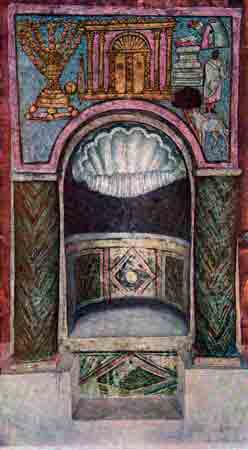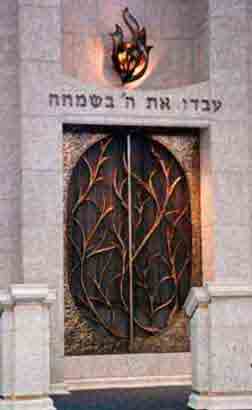SYNAGOGUES: INTERIORS
The interiors of synagogues have also reflected the
tension between Jewish particularity and cultural integration. At the
heart of every synagogue is the Torah shrine (the ark), which houses the
scroll (or scrolls) of the Torah. There is also usually a place from which
the rabbi speak to the congregation and leads the prayer service. In
medieval and early modern synagogues, the structure was like a "theater in the
round," with the ark in the back and the rabbi in the middle surrounded by the
congregation. This is evident in the oldest synagogue in the United
States, Tuoro Synagogue in Newport, Rhode Island:
 From
this perspective we are standing next to the ark, the Torah shrine, facing
towards the center of the room, where the rabbi would have stood on the raised
platform to lead the service. You can also see the gallery, where the
women would have originally sat separate from the men below.
From
this perspective we are standing next to the ark, the Torah shrine, facing
towards the center of the room, where the rabbi would have stood on the raised
platform to lead the service. You can also see the gallery, where the
women would have originally sat separate from the men below.
As Jews made their liturgies more "seemly," more in
conformity with the ideals of a serene, Protestant service, they likewise
adapted their synagogue interiors. Here is the interior of a neo-classical
synagogue from South Carolina:
 This
could easily be the inside of a stately southern church, or even a secular
public building: regular wooden
rows of seats (pews), the ark concealed in a gracious, Greek-style facade, the
raised dais with a lectern in the center.
This
could easily be the inside of a stately southern church, or even a secular
public building: regular wooden
rows of seats (pews), the ark concealed in a gracious, Greek-style facade, the
raised dais with a lectern in the center.
The ark, the Torah shrine, is often a
site at which traditional and "assimilationist" cultural tendencies collide.
The ark from the ancient synagogue of Dura Europos illustrates this:

The shell and the linear design are typical of Roman
decoration; the images above the ark, however, are romanized renderings of
sacred Jewish symbols: the seven-branched candelabra that had been in the
Second Temple and the "holy of holies" (central shrine of that temple) are
prominent here.

This Torah shrine from a synagogue in Boca Raton, Florida,
likewise combines traditional elements (Hebrew words that read "serve the lord
in joy," the vine and flame motifs that hearken back to medieval Jewish art)
with the neoclassical facade and regular masonry typical of more stately public,
U.S. buildings. Dual stone lecterns stand in front of the ark, for a rabbi
and cantor (song-leader).
continue with slideshow
 From
this perspective we are standing next to the ark, the Torah shrine, facing
towards the center of the room, where the rabbi would have stood on the raised
platform to lead the service. You can also see the gallery, where the
women would have originally sat separate from the men below.
From
this perspective we are standing next to the ark, the Torah shrine, facing
towards the center of the room, where the rabbi would have stood on the raised
platform to lead the service. You can also see the gallery, where the
women would have originally sat separate from the men below. This
could easily be the inside of a stately southern church, or even a secular
public building: regular wooden
rows of seats (pews), the ark concealed in a gracious, Greek-style facade, the
raised dais with a lectern in the center.
This
could easily be the inside of a stately southern church, or even a secular
public building: regular wooden
rows of seats (pews), the ark concealed in a gracious, Greek-style facade, the
raised dais with a lectern in the center.
